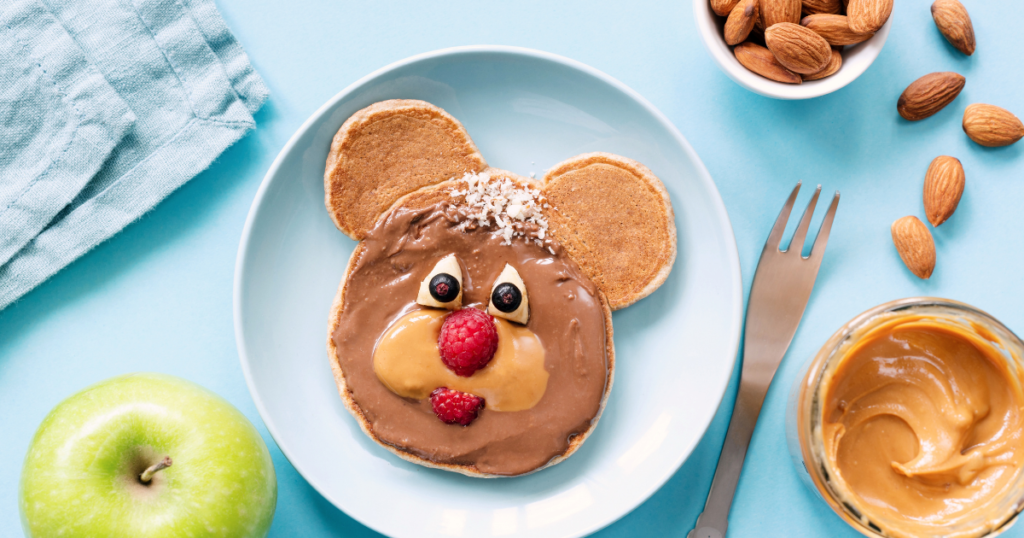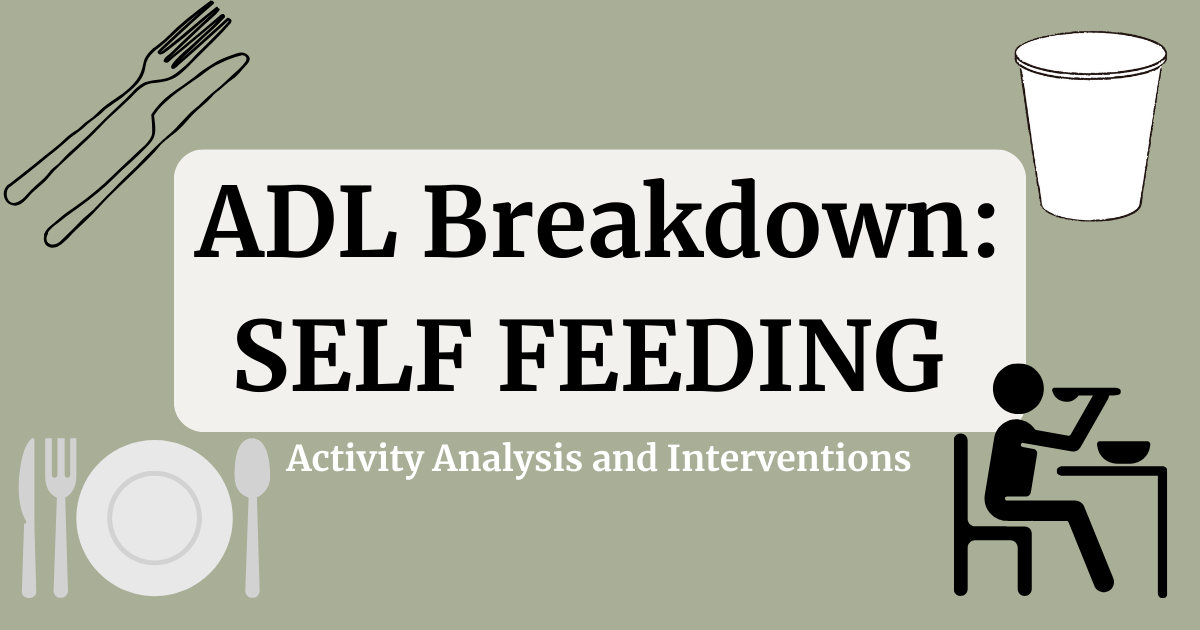Self Feeding Overview
Self-feeding is an essential daily living skill that occupational therapists often work on with individuals who may have difficulty due to physical, cognitive, or sensory impairments. To promote independence in self-feeding, therapists assess and address various skills and factors. In this article the key skills required for self-feeding from an occupational therapy perspective are broken down into two categories, physical and process skills followed by intervention ideas to target a specific skill component. Other important considerations for self feeding are also discussed at the end of the article.

Disclaimer/ Reminder: Self feeding is the activity that includes transferring food and utensils to/from the mouth. However, effective self-feeding also involves various oral-motor skills, including lip closure, tongue control, and swallowing coordination. In order for a therapist to address these components/ skills during a therapy session, special certifications are required. In most skilled rehabilitation settings, oral motor and swallowing skills are addressed by a speech language pathologist.
Physical Skills



Fine Motor: Precise hand and finger movements are crucial for tasks like picking up utensils, holding them, and manipulating food. Occupational therapists work on improving grasp, grip strength, coordination, and dexterity.
| Grasping and Manipulation Exercises | Therapists may use various objects of different shapes, sizes, and textures for clients to practice grasping and manipulating. This can include activities like picking up small objects, using tweezers, or squeezing stress balls. |
| Finger Strengthening | Strengthening the muscles in the fingers is crucial for self-feeding. Therapists may use resistance putty, finger exercises with rubber bands, or finger weights to improve finger strength. |
| Pincer Grasp Practice | The pincer grasp is essential for holding utensils and picking up small pieces of food. Therapists may work on this grasp by having clients practice picking up and transferring small objects like beads or cereal. |
| Fine Motor Control Games | Therapists may use board games, puzzles, cards, or activities that involve fine motor control, as well as other skills required for self feeding such as bimanual coordination, dexterity and , as part of therapy sessions. |
| Cutting Skills/ Bimanual Coordination | For clients who are working on using knives or scissors for self-feeding, therapists can provide activities that involve cutting paper, playdough, or food items like soft fruits. |
Posture and Core Stability: Maintaining a stable sitting posture is crucial for self-feeding. Therapists address issues related to core strength, balance, and stability to ensure safe and efficient feeding.
| Core Strengthening Exercises | Incorporate exercises that target the core muscles, including the abdomen and lower back. Strong core muscles are essential for maintaining an upright and stable sitting position. Therapists can demonstrate and guide clients through exercises during sessions. |
| Balance Training | Include balance training exercises to improve the individual’s ability to sit steadily during self-feeding. Activities like sitting on a stability ball or balance board can be incorporated into therapy sessions. |
| Weight-Shifting Exercises | Practice weight-shifting activities to help individuals shift their weight appropriately while seated. This skill is particularly important for individuals who may have difficulty adjusting their posture during meals. |
| Sitting Tolerance | Sitting tolerance refers to the individual’s ability to maintain an appropriate and comfortable sitting position for an extended period, such as during mealtime. As sitting upright with good support, rather than sitting up in bed is an ideal position for self feeding, occupational therapist can work towards increasing a patient’s ability to maintain a sitting position during treatment sessions. |
| Seated Yoga or Pilates | Introduce gentle seated yoga or Pilates exercises that focus on flexibility and postural control. These exercises can be adapted to the individual’s abilities and comfort level. |
| Provide Visual Feedback | Use visual cues, such sitting in front of a mirror or providing patient with pictures or diagrams, to help the individual understand the correct posture for self-feeding. Visual aids can serve as reminders to maintain proper alignment. |
Hand-Eye Coordination: The ability to visually guide the hand to the mouth while controlling utensils is essential. Therapists use activities and exercises to enhance hand-eye coordination.
| Utensil Target Practice | Set up a target (e.g., a plate or bowl) with small pieces of food, and encourage the individual to scoop or stab the food using a utensil and place it accurately into the target. This helps improve hand-eye coordination while mimicking the actions required during a meal. |
| Moving Target Exercises | Create a moving target by attaching a small object (e.g., a small toy or sticker) to a string or ribbon. Ask the individual to use a spoon or fork to “catch” or touch the moving object, enhancing tracking and coordination. |
| Balloon Volleyball | Play a modified version of volleyball using a balloon. The individual can use their hands or adapted utensils to hit the balloon back and forth with a partner. This activity promotes tracking and quick hand-eye coordination. |
| Bilateral Coordination Games | Engage in games or activities that involve using both hands together, such as catching and throwing a ball, shuffling cards or stacking cups. These activities improve coordination between the dominant and non-dominant hand, which is essential for self-feeding. |
| Visual Tracking Apps | Utilize interactive apps or computer programs designed to improve visual tracking and hand-eye coordination. There are many apps available that offer engaging exercises and games. |
Process Skills


Sensory Processing: Some individuals may have sensory sensitivities or aversions that affect their willingness to eat certain foods or use specific utensils. Occupational therapists help individuals develop tolerance and adapt to sensory challenges.
| Desensitization Techniques | Gradual exposure to sensory stimuli is a common approach. Start with foods that are less challenging in terms of texture or taste and progressively introduce more challenging items. Encourage clients to touch, smell, and eventually taste these foods. This may be important for patients who are on a modified diet. |
| Food Play | Engage in sensory exploration activities with food that involve touching, squishing, and playing with different textures. This can help desensitize individuals to unfamiliar sensations. |
| Food Art and Creativity | Incorporate food into art activities, such as making food collages or using food as a paintbrush. This can make the experience of interacting with food more playful and less intimidating. |
| Environmental Considerations | Create a calming and sensory-friendly mealtime environment. This may include using soft lighting, playing soothing music, or using a designated sensory space for breaks if needed. Also, provision of utensils and tableware that accommodate sensory sensitivities, such as those with textured or weighted handles, or using a divided plate. These can offer comfort and stability during self-feeding. |
| Multi-Sensory Meal Preparation | Involve the individual in meal preparation activities to engage their senses. This can include washing, cutting, and mixing ingredients, which allows them to become more familiar with various food textures and smells. |
Cognitive Skills: Planning, sequencing, and organizing the steps involved in self-feeding require cognitive abilities. Therapists may work on memory, attention, and problem-solving to ensure individuals can complete the task independently.
| One-Step Instructions | Break down instructions into simple, one-step commands. For example, instead of saying, “Take a bite of the chicken, then a bite of the vegetables,” you might say, “Take a bite of the chicken” and wait for compliance before giving the next instruction. |
| Routine and Structure | Establish a structured mealtime routine with consistent timing and a familiar environment. Predictability can help individuals with cognitive impairments feel more comfortable and capable during self-feeding. |
| Task Simplification | Simplify the self-feeding tasks whenever possible. For example, pre-cut food into manageable pieces or serve foods that are easy to scoop with utensils. You may also offer one food item an/or utensil at a time to reduce the amount of choices the patient much consider. These interventions reduce the cognitive load and makes self-feeding more manageable. |
| Offer Familiar Foods | Initially, try offering familiar and preferred foods that the individual is more likely to recognize and enjoy. This can reduce cognitive challenges related to food selection. |
Communication Skills: For individuals with communication difficulties, therapists may work on alternative communication methods to express food preferences or needs during mealtimes.
| Visual Menus | Develop visual menus or choice boards that display meal options with accompanying pictures or symbols. Individuals can use these menus to indicate their food choices. |
| Augmentative and Alternative Communication (AAC) Devices: | For individuals with severe communication difficulties or non-verbal individuals, introduce AAC devices such as communication boards, speech-generating devices, or communication apps. Teach them how to use these devices to express their needs and preferences. |
Emotional and Behavioral Factors: Some individuals may have emotional or behavioral challenges related to self-feeding, such as food refusal or anxiety. Emotional or behavior factors may impact an individuals ability to share a meal with others in a group dining environment. Therapists may use behavioral strategies and emotional support to address these issues.
| Prompting and Modeling | Use prompts and modeling to encourage the use of communication. For example, you might model asking for more water and then prompt the individual to do the same. |
| Turn-Taking and Conversation | Encourage turn-taking during mealtime conversations. Promote listening skills and taking breaks for individuals who may have difficulty sustaining attention or conversing for extended periods. |
| Visual Timers | Use visual timers to help individuals understand the duration of the meal and when it will end. This can reduce anxiety related to mealtime. |
| Coping Strategies | For individuals who are prone to having outbursts due to overstimulation, anxiety, etc., during mealtime integrating coping strategies or relaxation techniques can be a helpful intervention. |
Other Considerations

Mealtime Management: Occupational therapists also play a role in managing the overall mealtime environment. This includes ensuring appropriate seating and positioning, adaptive seating devices, and creating a calm and pleasant atmosphere to enhance the dining experience.
| Environmental Adaptations | Therapists may suggest modifications to the dining environment, such as proper seating height or lighting, to optimize self-feeding conditions. |
| Adaptive Equipment and Assistive Devices | Occupational therapists evaluate and recommend appropriate adaptive equipment or assistive devices such as special utensils, plates, or adaptive seating to facilitate self-feeding |
| Mealtime Routines | Establishing consistent mealtime routines and promoting a positive mealtime environment can also be part of occupational therapy intervention to encourage self-feeding. |
Collaboration: Occupational therapist will collaborate with family/ caregivers, speech language pathologists (SLP), nurses, and support staff to encourage carryover of interventions outside of therapy sessions.
| Family/Caregiver | With individuals who require assistance, therapists often work with family or caregivers to teach them how to support and facilitate self-feeding at home. Education on proper positioning, use of adaptive equipment, implementation of aspiration precautions, etc should be completed prior to a patient discharging. Speaking with family/ caregivers as you work on self feeding is important in order to gain a better understanding of how the patient was completing this ADL prior to their need for OT intervention. They can provide insight on food preferences, ideal mealtime environment, or may provide a familiar face and company during mealtime that can be encouraging to a patient as they work self feeding. |
| SLPs | SLPs provide guidance on safe and effective swallowing techniques and may recommend modified food textures or specific diet modifications to reduce the risk of aspiration or choking. It is extremely important to be aware what type of diet a patient has been prescribd to reduce the risk of aspiration. OTs can reinforce safe swallow strategies addressed during speech therapy sessions and speech therapists can encourage use of adaptive equipment and positioning devices during their sessions. |
| Nursing | Nurses contribute their expertise in assessing the patient’s overall health, vital signs, and any medical conditions or medications that may affect eating or pose choking risks. Updating nursing staff regarding how much a patient consumed or any concerns that came up during mealtime is important to ensure all disciplines have the most up to date information. |
| Support Staff | CNAs and RNAs may be providing one to one feeding assistance or supervision, or may be simply setting a patient up for meals. Educating support staff regarding use of adaptive equipment, implementing safe swallow strategies, and providing education for how to appropriately set up or position a patient during mealtime can led to increased independence with self feeding and increased nutritional intake. |
Summary
It’s essential for occupational therapists to conduct thorough assessments and collaborate with other healthcare professionals, such as dietitians and speech-language pathologists, to develop individualized plans of care for self-feeding. These plans consider the resident’s unique needs, progress, and any underlying medical conditions. The goal is to optimize independence in self-feeding while ensuring the safety and well-being of the individual.
